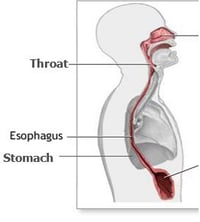Allergic esophagitis
What is eosinophilic esophagitis (EoE)? 
EoE is a problem with the tube that connects the throat to the stomach. This tube is called the food tube or esophagus. With EoE the lining or skin of the esophagus becomes swollen and sometimes scarred. Most children do not grow out of EoE which means it is a lifelong condition but there are many effective treatment options. Treatment can include: long-term diet changes, swallowed inhaler medications, acid blocker, or injection medications. Staying on a treatment long term will control the disease and prevent problems. Anyone can get it, but it happens more often in:
- School-age children.
- Children whose families have allergic diseases like asthma, hay fever, food allergies, or eczema.
What are the symptoms?
- In infants and young children: Feeding problems, slow weight gain, and vomiting.
- In school-age children: Vomiting, chest, or stomach pain.
In older children and teens: - Swallowing problems. This is called dysphagia.
- Food getting stuck in the esophagus. This is called food impaction. The problem gets worse the longer EoE goes untreated. This sometimes results in emergency endoscopy for food removal.
- Slower eating, picky eating or needing water to wash food down.
How is it diagnosed?
The doctor will use a long camera to take a small piece of skin (biopsy) from the esophagus. This is called an endoscopy.
How is it treated?
Your team of health care providers will include:
- Gastroenterologist (GI). This doctor does the endoscopy. The GI doctor talks with a pathologist about the biopsies.
- Allergist. This doctor helps treat and manage food allergies, hay fever, asthma, or eczema.
- Nurse. The nurse coordinates care and answers questions between clinic visits.
- Dietitian. This person talks about nutrition and foods that may need to be taken out of your child’s diet. They also suggest foods and drinks that are safe and meet your child’s nutrition needs.
Treatment may include taking foods out of the diet or taking medicines. A few things may need to be tried to find the best treatment for your child. A variety of visits may be needed:
- Visits for endoscopies to see if the treatment is working.
- Dilation: stretching of the esophagus during an endoscopy may be needed to improve symptoms. This is called dilatation.
- Gastroenterologist and dietitian visits. They will check:
-Success of treatment.
-Management of other medical concerns.
-Growth and nutrition.
Diet
Diet changes are one kind of treatment. Foods are taken out of the diet. This does not cure the disease, but it keeps it from coming back. At this time, there are no reliable tests to know which foods need to be removed to treat the disease. Doing an endoscopy shows whether taking foods out of the diet treated the esophagus. Foods can then be added to the diet one at a time. This is called food elimination. It can be done several ways:
Empiric elimination diet. Foods that often cause EoE are taken out of the diet.
There are three common empiric elimination diets.
Six foods elimination. This means taking out:
- Dairy
- Soy
- Eggs
- Peanuts and tree nuts
- Wheat
- Shellfish and Fish
Four foods elimination. This means taking out:
- Dairy
- Wheat
- Eggs
- Soy
Single food elimination. This means taking out dairy.
Complete elimination. This is also called an elemental diet.
This diet is for children who are very allergic to foods or who have feeding tubes. Age-appropriate liquid formula will replace food. These formulas are made up of individual amino acids. The immune system will not react to the formula and these formulas are allergen free.
The formula has all the nutrition needed to help your child grow and develop. Often, a large amount must be given. A feeding tube may be needed to help your child get all their nutrition.
Medicine
Medicines are another way to treat EoE. They do not cure the disease. Stopping the medicine may cause the symptoms to come back.
- Acid blockers. These are also called proton pump inhibitors (PPIs). These may be used to treat and decrease swelling in the esophagus. Examples include omeprazole and lansoprazole. Medicines that are used to block acid for acid reflux disease have been shown to help patients with eosinophilic esophagitis.
PPIs are safe. Rare side effects in children include a higher risk of some infections. An endoscopy is the only way to check if the treatment is working.
- Swallowed steroids. Steroid inhalers much like those used for asthma are the main medicines used to treat EoE. These medicines stay in the food tube (esophagus). The body rarely absorbs these medicines and they are very safe. They decrease swelling caused by the immune cells or the eosinophils. Examples include swallowing fluticasone from an inhaler or drinking thickened budesonide, flavored with a sweetener like honey or maple syrup. The main side effect is a yeast infection called Candida in the mouth or esophagus. Candida can be treated with a short term medicine and is not dangerous.
- Oral steroids (prednisone). These often help but are not often used. Oral steroids affect the whole body. Side effects include weight gain, high blood pressure, bloating, and mood changes. If these side effects can be managed, the medicine is useful.
- Dupilumab (brand name Dupixent®). This medicine is given every week or every other week, with a shot. It treats inflammation in EoE. This is approved for children over 1 year old who weigh more than 15 kg (about 33 pounds). Common side effects include pain where the shot was given and skin rash.
Where can I get more information?
Information about your child’s case should come from your child’s health care team.
For other health and wellness information, check out this resource: https://kidshealth.org/ChildrensWi/en/parents



